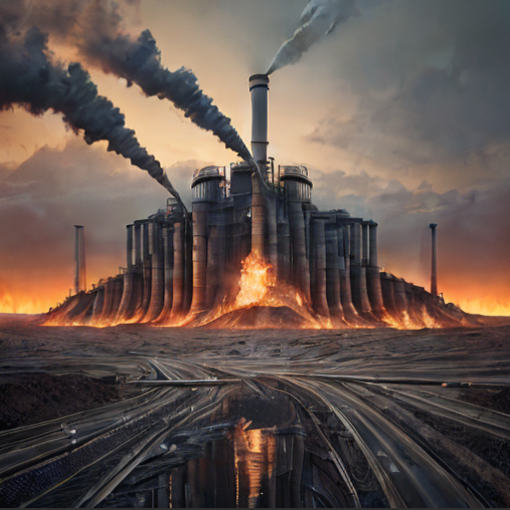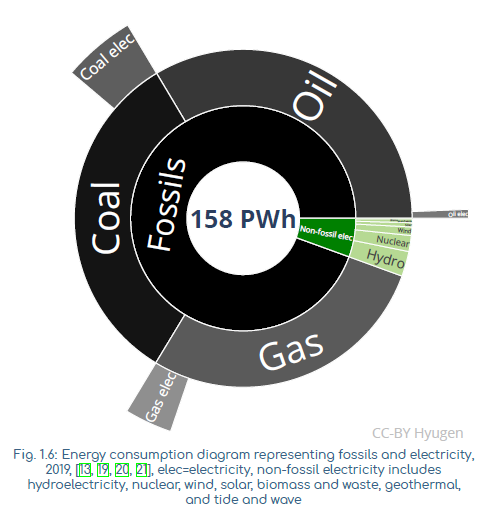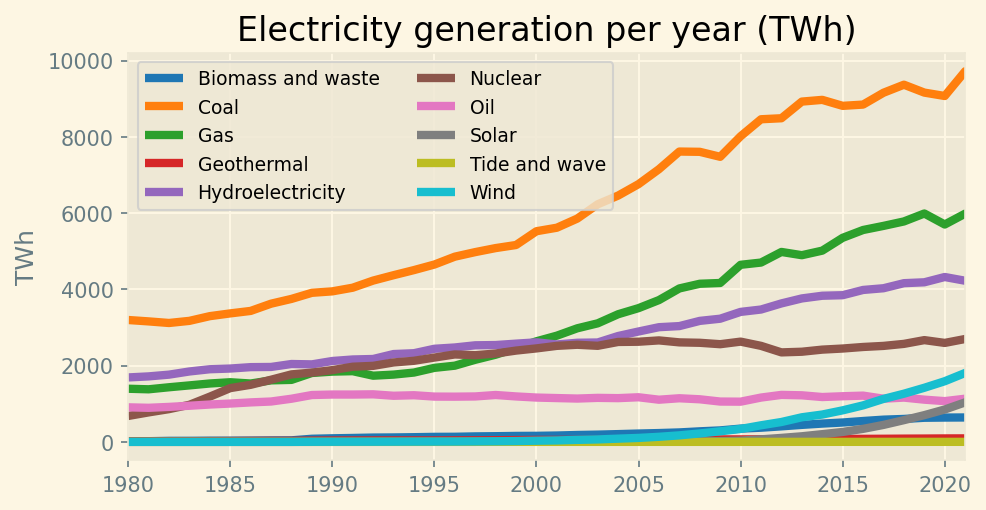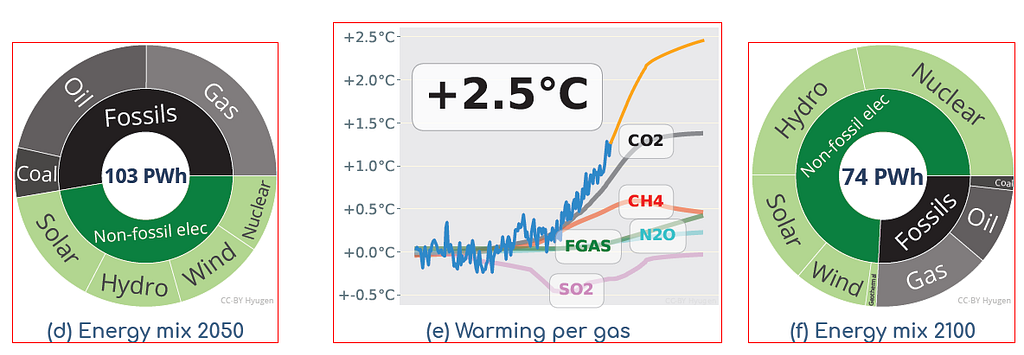
Can we really grasp how much fossil fuels we consume each year? Is it a lot? Not that much? Can we easily do an energy transition for climate change? Or is our consumption of fossil fuel so fundamental that to imagine a world without it is a fantasy?
Well… it’s not a fantasy. Just 200 years ago, we didn’t have access to fossil fuels as much as we do today. But I guess we all want to do this energy transition without going back 200 years in the past.
This article is part of a series on the DEC Report. The DEC report is a 200+ pages freely accessible report I wrote on climate change and energy. It assesses the world’s potential to tackle climate change by removing GHG emissions in energy and agriculture, and it assesses how we can optimize this transition.
- ➡️➡️ The DEC Report (pdf)
- 🌊 Hydropower potential (1/8)
- ☀️ Solar potential (2/8)
- 🌬️ Wind potential (3/8)
- 🏭 Nuclear potential (4/8)
- 🛢 How much fossil fuel do we consume each year? (5/8)
- 🔥 Energy, EROI and limits to growth (6/8)
- ☢️ How many people died because of the Chernobyl disaster? (7/8)
- ⚡ Why do we close nuclear reactors? (8/8)
Fossil fuels
Fossil fuels include:
- Coal,
- Oil,
- and Natural gas (gas)
They’re formed naturally in the Earth’s crust from the remains of dead plants and animals. Coal is a solid. Oil is a liquid. And natural gas is… yep.. a gas. They can all be measured thanks to a single unit: an energy unit. I’ll use TWh / PWh in this article because it’s the usual unit for electricity, and electrification is one of the main solution to reduce GHG emissions from energy, so it’s easier to compare electricity and fossil fuels.
Energy
Your body heats, and you emit about 100 Wh at rest.
- …That’s 0.1 kWh.
- kWh — With 0.3|0.2 kWh, you can do 1 mile|km in an electric vehicle.
- kWh — With 1 kWh you can play a AAA video game on a high-end computer for 2~3 hours.
- kWh — With 2 kWh you can take a shower.
- kWh — With 10 kWh you can power a small appartment for a day
- kWh — EV batteries are generally between 30 and 60 kWh.
- kWh — The tank of an average car can hold about 400 kWh of oil.
- kWh — An average wind turbine can produce 1000 kWh in 30 minutes
- MWh — In wealthy countries, machines consume more than 10 MWh per people per year on average
- MWh — A small gas turbine can produce more than 300 MWh of electricity in 1h
- GWh — A large nuclear reactor can produce 1.6 GWh of electricity in 1h
- GWh — Andorra consumes 200 GWh of electricity per year (2019)
- TWh — A large nuclear bomb releases 60 TWh of energy
- TWh — France consumes 550 TWh of electricity per year (2019)
- TWh — The world produced ~11000 TWh (11 PWh) of low-carbon electricity in 2022
- TWh — The US consumes 24000 TWh of fossil fuels per year (2019)
- PWh — China consumes 40 PWh of fossil fuels per year (2019)
- PWh — The world consumed ~150 PWh of fossil fuels per year (2019)

So, is the idea to have these 11 PWh of low-carbon electricity replace these 150 PWh? …Well, not exactly. In fact, a large part of these 150 PWh are wasted because machines we use to convert energy from these fuels are not 100% efficient, but rather 30% efficient. In the world we use a lot of coal to produce electricity, ~75% of the coal energy used to produce electricity turns into waste heat. We also use a lot of natural gas to produce electricity, except it’s more efficient, ~66% of the gas energy used to produce electricity becomes waste heat. We don’t use oil a lot to produce electricity. But, we use oil in cars, planes, trucks etc., ~70% of the oil energy used in engines is lost as waste heat.
But, we don’t use 100% of fossils for electricity or to move vehicles. The efficiency of fossil fuels used for heating is usually much higher and closer to 100%.
We can estimate how much useful energy we consume. It’s important because that’s approximately the electricity we would need to produce to replace fossil fuels, as using electricity is usually much more efficient.
- We know how much fossil fuels we consume each year (~150PWh)
- We know how much electricity we produce thanks to these fuels each year (~17 PWh)
- We don’t exactly know how much the rest is used for moving vehicles (~30% efficiency) vs heating (80~95% efficiency) but we can estimate these values.
For example, if a country needs 100 TWh of natural gas and produces 30 TWh of electricity from gas, they probably had ~70 TWh of waste heat, so we don’t need to replace 100 TWh of energy, we just need to produce 30 TWh of low-carbon electricity (we ignore the “quality” of the electricity produced, intermittency, grid constraints, etc.). We don’t need to replace the waste heat.
So, 17 PWh of electricity from fossils (mainly gas/coal) means ~34 TWh of waste heat from fossils (1/3 elec, 2/3 waste). Out of the 57 PWh of oil, approximately 2/3 are used in processes with a low efficiency (vehicles, electricity), so 57PWh*2/3*2/3 = 25PWh of waste heat (1/3 useful energy, 2/3 waste heat). We already have 34+25=~60 PWh of waste heat, with losses on other uses (industry, heating..) we estimate this amount at ~65 PWh.
- 150 PWh of fossil energy — 65PWh of waste heat = 85 PWh of useful energy.
So, we would need to produce ~85 PWh of electricity to replace fossil fuels with electricity alone.
We’re currently producing ~11PWh of low-carbon electricity, this amount increased by approximately ~0.5 PWh/y during previous years. This means that, if systems we currently install had an infinite lifespan, we would have replaced fossils in 170 years… The target for climate change is usually 2050, so in 27 years. We’re not there yet.
We can do a more in-depth investigation.
- We’re currently installing solar systems at approximately ~300GW / year. Solar systems have a capacity factor of ~15%. 300 * (365*24)/1000 * 0.15 = ~400 TWh = +0.4 PWh/y.
- For wind it’s ~100 GW/y and ~25%. 100 * (365*24)/1000 * 0.25 = ~200 TWh = +0.2 PWh/y.
- Nuclear power has not really increased during previous decades as multiple countries decided a phase-out = +0PWh/y
- For hydro it’s ~25 GW/y and 33%: +0.07 PWh/y.
This is the current increase in low-carbon electricity production. In order to remove all fossil fuels by 2050, we would need to be 6 times faster and install 3 PWh / y rather than 0.5~0.6 PWh/y. And we would need to be faster in a world with less fossil fuels (which contribute to how fast we are now) and with more climatic constraints. AND, of course, systems we’re currently installing don’t have an infinite lifespan. For solar panels, it’s ~25 years. For wind turbines, it’s ~20 years. Which means we would need to be even faster to be able to keep replacing these systems.
Thanksfully, electricity isn’t the only solution. However, all solutions have constraints and reducing our consumption of fossil fuels won’t be easy, as they fuel our lifestyles.

Results in the DEC report
In the DEC report, I provide one strategy:

All the details on this strategy and on the methodology are in the report!
Links
You can see how some of these results were used in much more details in the DEC report. Some of the data and models I used are also available on Github.
👏 if you liked this article and I’ll do more!